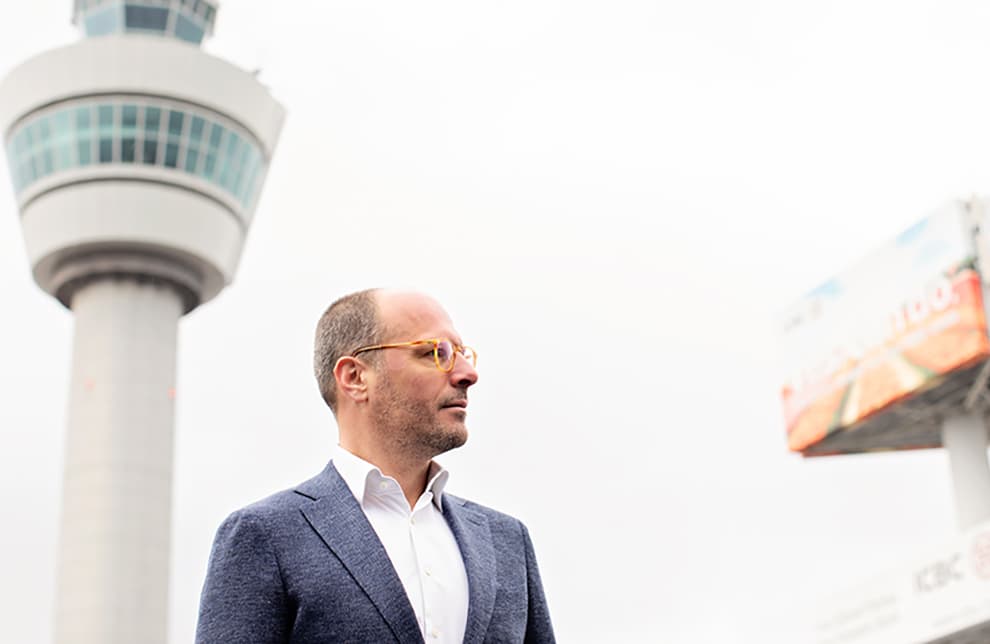Schiphol remains unique – and will stay that way
After travellers check in and complete their security check, they spend an average of two hours in the airport. Once controls are completed, passengers have plenty of time and are open to a little spending. So, how can you use Out of Home media in a way that makes both travellers and brands happy?

Maarten van Maaren is the new director of Schiphol Media. Less than two weeks after he started, he was confronted with the corona crisis. ‘These are very special times, but we are also a special company, at a special location,’ he says. ‘Of course, I would have liked to have started this new role differently. But despite all the hectic work, the team ensured that I had a smooth start.
‘These are very challenging times. The coronavirus is having an enormous impact on the world of travel, on airlines and on Schiphol. The number of flight movements and passengers has drastically dropped. Together with our partners and clients, we’re putting our noses to the grindstone. New developments will certainly occur in the near future, since this uncertain time calls for flexibility and creativity. But we are used to working in a customer-centric, creative and innovative way. And we’ll continue to do just that!’
Taking up residence
Schiphol is practically a city in and of itself. And it has an outstanding reputation as a pleasant and convenient airport to visit and occupy. With an average of more than 71 million passengers a year, it is the third-largest airport in Europe. It’s therefore a very interesting place for brands to present themselves. ‘We have attractive areas for shopping, eating and drinking, and even a museum and an English pub. Major international brands like Rolex and Chanel, but also classic Dutch brands, consciously choose to have a presence at our airport with billboards or lightboxes. But of course, we offer a lot more than just media screens.’
Short lines of communication
Primarily, Schiphol Media seeks partnerships, and an integrated approach with which brands can seek cooperation with retail and catering. ‘In the world of airport advertising, we are quite unique. We have our own, in-house media organisation, which means that there are very short lines of communication between retail partners, brands and daily operations. The Rituals campaign is a great example of this integrated approach. During the holiday season, there is an enormous Christmas tree, filled with Rituals products. These are for sale in shops, but also at the gates in the form of stylish gift carts filled to the brim with gift sets that are perfect for last-minute sales. Everything conveys the complete Rituals experience to the passenger.
‘Another example is Samsung. It promoted its latest product with a pop-up store in a unique location. Awareness on the screens and also a physical point where travellers could get information, try the product and buy it. The best thing for your brand campaign is to integrate the physical product. Made.com also created waiting areas with their furniture, and Audi offered VIP transport directly to the aircraft. Things like these add value for the traveller, for the brand and for Schiphol.’
Top of mind
‘Of course, it’s important to reach your target audience as effectively as possible. We can adapt our digital screens very quickly and specifically to your target group. For example, we know which flights Chinese tourists arrive on, and which gates they arrive at. At those times, we can display information in Chinese on the screens, including information about access to the WiFi network. On a special landing page, in addition to practical travel and accommodation information, they can also find offers that are relevant to them.
‘If you want to attract families with children, you can use the screens and baggage belts in the departure hall for budget airlines and charter companies during school holiday periods. And when they return and are waiting for their baggage, they can see information from Intratuin (gardening centre) or Squla (children’s educational games), along with relevant offers to make the return home more pleasant. You can promote business leasing for cars with test-drives to the Privium car park and to the departure hall. We were also the first to welcome BUD, ‘”the king of beers”, to the Netherlands. Because where better to do that than at Schiphol?’
Van Maaren has even more examples: ‘we also make smart use of data for branding campaigns at the gates. There, the screens show news, videos and the weather at the final destination. We can supplement that with relevant offers available near the gate, like sunglasses, sunscreen or an umbrella. The screens put your brand top of mind at just the right time.’
Consumer intelligence
‘Our desire to be relevant for brands includes extensive and thorough reporting to our clients about their reach and impact. We already measure quite a lot, but it can always be smarter. We follow group movements and traffic flows, and we do eye-tracking research. For that research, we asked travellers to walk around wearing special glasses, and we followed their eye movements. We can see what they were looking at, and for how long. At the gate, we asked them about what they saw and could recall. With integrated promotions, we can indicate how often a brand has been shown on the screens, how many travellers have seen or tried the product, and how many have been sold.’
Focus on the future
‘Despite the current crisis, we still see plenty of opportunities and possibilities. On Schiphol.nl, in the app and on our YouTube channel, there is primarily operational information about flights right now. I would very much like to integrate these digital channels into our total product offering.
‘It’s all about finding the right combination of information, entertainment and offerings,’ van Maaren concludes. ‘That’s how an advertiser can contribute to an optimal passenger journey.’
Text BBP Media | Image Zuiver Beeld